Tucked away beneath Dartmoor's highest point, AKA the ‘roof of Devon’ and the highest point on Dartmoor, lies a remote valley and a mystical ancient rainforest. Black-a-Tor Copse is one of the three ancient oak woodlands on Dartmoor, one of the others being the better known Wistman’s Wood. Areas like these are classed as temperate rainforests, and are extremely special places. They used to cover much of Britain but now only 1% of it's original coverage remains: it is only in particular upland places in the west UK that they can be found. They are home to a range of exotic flora and fauna worthy of any rainforest: truly a beating heart of vibrant nature. If you fancy seeing one of the wildest places in England without sharing it with other walkers, then pay a visit to Black-a-Tor Copse.

ROUTE DETAILS
Time: 1 hour each way, or 3 hours for a circular route. Leave plenty of time to spend at the copse!
Terrain: Rocky track and some walk across open moorland: boots recommended
How to get there: Parking at Meldon Reservoir car park (£2 all day) or get the train to Okehampton where you can walk to the reservoir
Refreshments: No pubs here, although a picnic in the copse is as magical as it gets. Pack accordingly!
Directions: OS map route here. This is my preferred route which takes you on a circular route up to Yes Tor and the Roof of Devon after the copse. This is harder walking and takes longer than if you just go back the way you came
THE WALK
Starting at Meldon Reservoir car park, you will be immediately greeted by sweeping views of Meldon Reservoir. This is a beautiful spot: views beyond the lake to the brooding hills beyond, and down the Okement valley. The reservoir exists because of the dam completed in 1960. You can tell how deep the water is by looking over the other side and seeing the drop for yourself! The dam reminds me of the one in GoldenEye (fans of James Bond and Nintendo 64 will know)
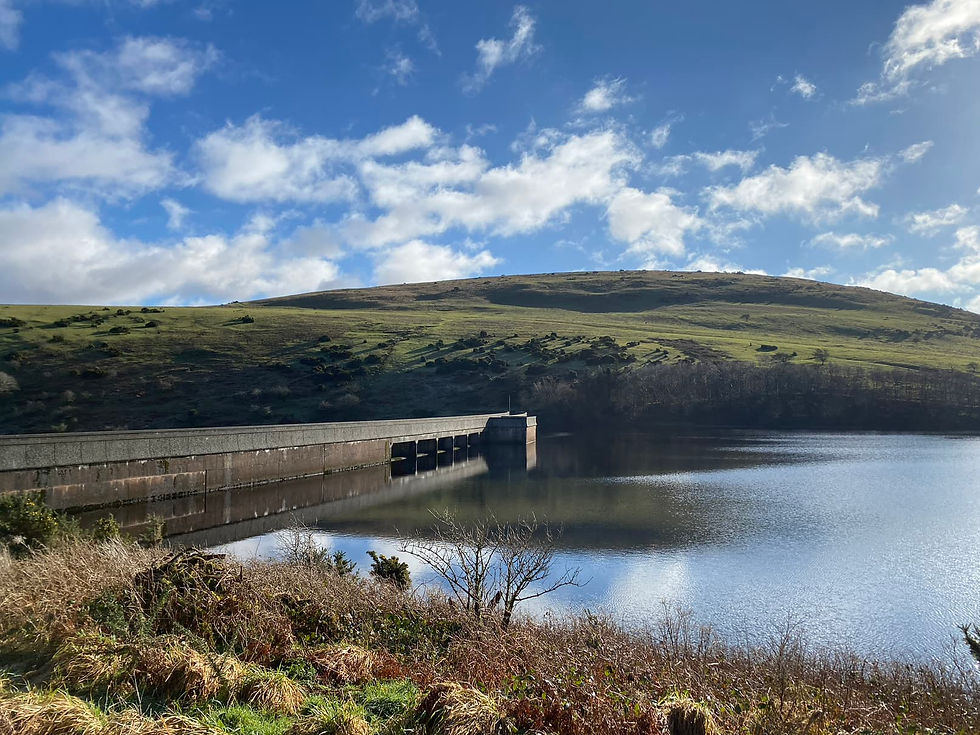
Cross the dam and follow the path that winds around the reservoir until you reach the West Okement river that flows into it. As you follow the track up the valley, the river is hidden by steep-sided banks and mossy oaks. There is no path down to it, but a careful scramble down the banks will reveal a series of pools, with waterfalls roaring over boulders the size of buses. It’s one of those spots that makes me think “Am I really still in England?” Either way, it's paradise: a great place to spend hours reading on the banks, or refreshing yourself with a dip in the cool waters. Just don't get distracted as it gets even better further upstream!
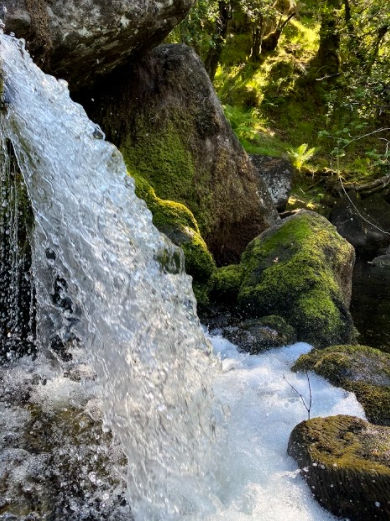
Eventually you will come to an old stone wall and a weir. Continue past this until the path disappears and your route continues over open moorland. Depending on the time of year you may have to pick your way through some boggy spots: but you will soon see the trees of Black-a-Tor Copse fast approaching.
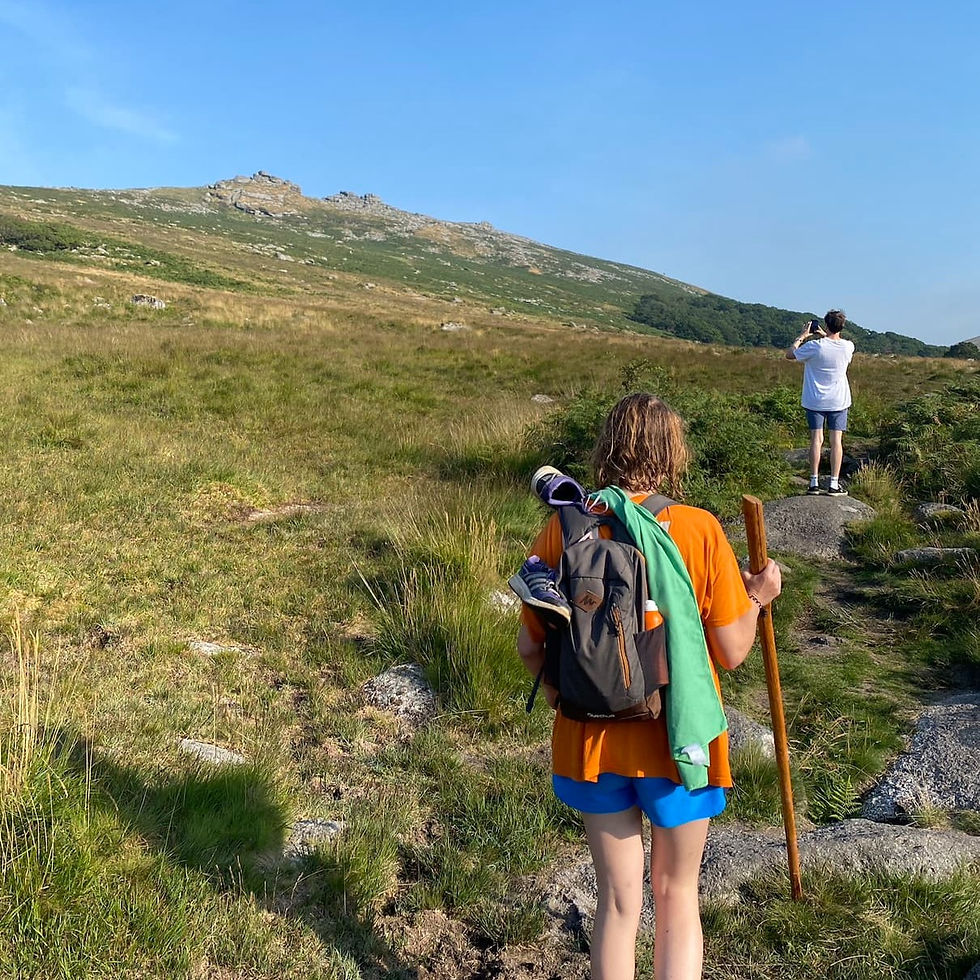
A VERY BRITISH RAINFOREST
Once you arrive at the copse, the path continues up along the river. The trees line the valley for about 500 metres, enclosed on both sides by steep-sided hills that add to the sense of vast remoteness. There is no path through the woodland: you can head straight in or follow the river and pick your preferred spot of entry. Whatever time of year, the place is rich with life: a stronghold of nature away from the onslaught of civilisation. Step inside amongst the boulders and enter a vivid green world where time moves at it's own pace, essentially unchanged since described by Dartmoor buff Eden Phillpotts in 1906:
“Black Tor Copse spreads straggling under the granite masses above. It is a stony grove set in a wilderness, flanked by the steep of a mountain on one side, fringed by the silver of Oke upon the other. The song of this river met the lisp of the leaves in ceaseless strophe and antistrophe through summer months. Now the wind woke the foliage and diminished the voice of the water ; now the tinkle and whisper of glittering falls dominated any listening ear with their music. Sometimes the trees slept and not a leaf stirred ; sometimes their arboreal slumbers would suddenly be broken by a mighty clatter, when blue-winged wood-doves clashed away from hiding-places under the low boughs. Or at twilight a fox might bark and break the primal peace of this most ancient wood. These and countless lesser things knew the place for home ; but conscious creatures rarely haunted it.”
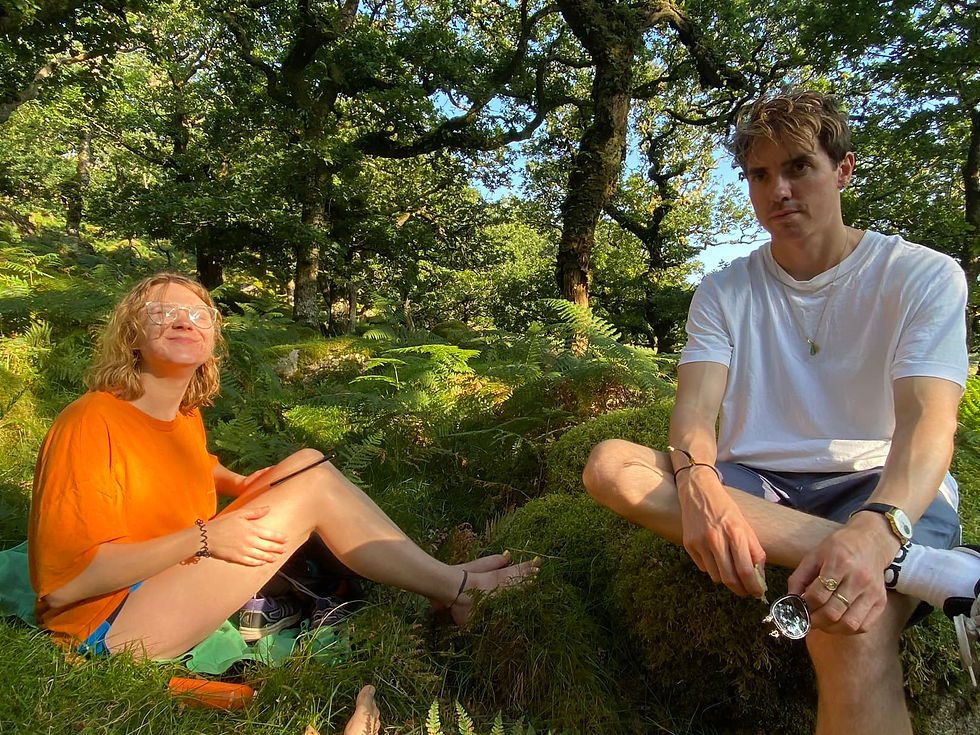
The trees (mostly oak) are given their wizened, gnarled appearance by the winds that blast down the valley, stunting their growth but creating the perfect environment for the life that depends on them. There's a vast abundance of mosses, lichens and liverworts, including some that can only be reliably found here. Some twenty species of breeding birds have been recorded in the woodland and surrounding habitat, including the elusive Ring Ouzel. You don't have to be an expert on lichen identification (I call the hanging ones ‘tree beards’) or bird-spotting to appreciate the remarkable natural beauty that oozes out of this place. This is definitely forest bathing at it’s finest: you can practically hear the forest breathe around you. But please remember to be mindful of your environment: it may be very old, but that’s because the boulders have largely succeeded at keeping out hungry sheep and clumsy footed humans. Tread carefully so as not to disturb any of the delicate species of flora and fauna.
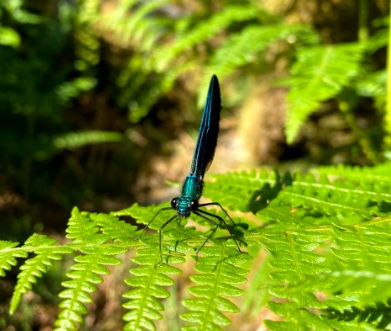
Naturally it's believed that the copse has ancient associations with nature-worshipping druids. This is difficult to prove, but a) if a druid was going to worship nature anywhere this would make a fine spot and b) there are plenty of druids around today and I'm sure they still like it here!
It's also easy to imagine (and hard to argue) that if magical beings were to choose anywhere as their home, this would be it. Legend has it that this is a haunt for Dartmoor piskies; also known as pixies; magical fairies with a flair for mischief. There is a superb tale about the Battle of the Piskies, where Black-a-Tor Copse was supposedly the holdout during a great magical conflict. It's a great tale to read while sitting beneath the velvety green oaks: see here for the story. There's no signal in the copse though so you will need to save it in advance, or head up the hill until you get some reception!

THE ROOF OF DEVON
When you’ve had your fill of the copse, the easiest way back to the car park is to retrace your steps back down the river. Or if you have time, you can scramble up the steep hillside to Black-a-Tor, a pile of rocks loom above the woodland. Even if you’re planning to walk back the way you came, the short but steep walk up to the tor will reward you with far-reaching views over Devon. I could see the sea by Plymouth at sunset!
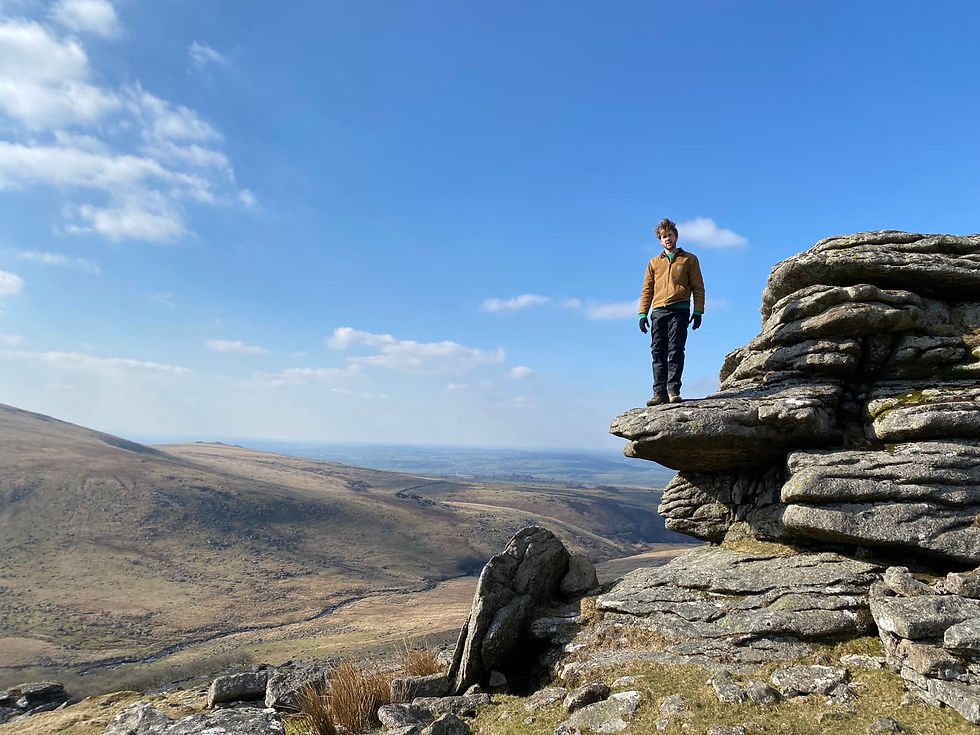
From here, I recommend a trek to High Willhays, the highest point on the moor. This route may involve picking your way through more boggy ground, but if you've got the right footwear then it's more than worth it. Be aware that this route past Black Tor takes you into the Okehampton military firing range. Check a map and firing times online to be sure it’s safe to walk. There is usually no firing on weekends, but definitely check on weekdays.
Once atop High Willhays, you will continue your circular walk along the moor to the equally impressive Yes Tor, drinking in sensational views all the while. You can then head across the moor downhill, back toward the reservoir to finish your walk: check your map to pick up a track to make things easier.
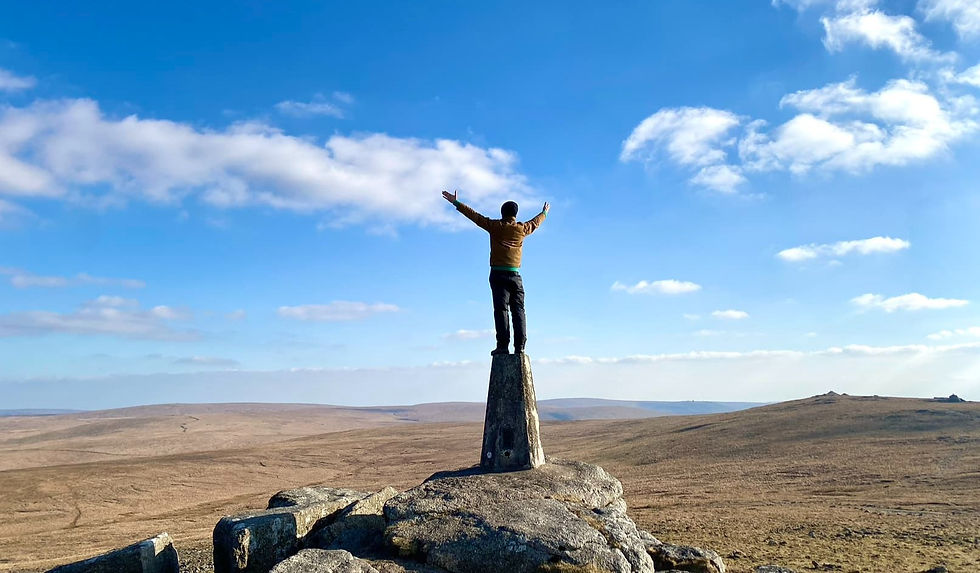
Special thanks to Legendary Dartmoor for the historical passages and ancient legends. The tale below of the Battle of the Piskies was originally found on Legendary Dartmoor (I'm not sure where it came from originally) but as the page has been taken down I will recount it here as it is too good to lose!
THE BATTLE OF THE PISKIES
For centuries it has been a known fact that piskies live on Dartmoor and are famous for their good deeds they perform for true believers. OK, at times they can be mischievous, especially if somebody has crossed them, but even then the tricks they play are fairly harmless. But way back in the dusty corners of time there were in fact two sorts of piskies. There were the ‘good’ piskies who lived in the moorland combes and often would visit the farms and cotts of a night. But there were also the ‘evil’ piskies who lived deep down in the tin mines of Dartmoor, their sole purpose was to wreak havoc and mayhem in the human world. So as not to cause confusion let’s call the little folk who lived on the moor – piskies and those that lurked down the mines – peskies. It could be said that to compare the two races was like comparing ‘chalk with cheese’ and to toss in another adage – ‘oil and water do not mix’.
Maybe it would be as well to explain something here. Because the piskies helped the folk they favoured they would always be given food, drink, clothes and other treats which could not be said for the underground peskies. The only humans they came into contact with were the tin miners who basically were a mean lot and treated them with contempt. So to say there was a degree of jealously between the two races would be an understatement.
Gradually over time the resentment grew and grew amongst the peskies, at first it was just a few dust-ups, (more like handbags at dawn really) whenever the two should meet and maybe, on the odd occasion the peskies would gate-crash a piskie revel or two. However, one day a gang of peskies were sat at the entrance to an old mine adit when they spotted a lone piskie out collecting nectar from the Cowflops growing in a nearby gert. Now for a piskie to be on their ‘turf’ was bad enough but to be there in plain site of the peskies was asking for it and so accordingly he got ‘it’ in a big way. Not to put a finer point on it they kicked the living daylights out of him and sent him home with a message – this meant war!
Now, because the peskies lived in the tin mines that had learnt by watching the miners how to smelt metal but instead of making tin ingots they made swords and arrow heads which meant they had weapons of mass destruction. Whereas the piskies had no such technology, probably the most offensive weapons they had were the baskets they collected their ‘hurts‘ in which was not the ideal situation to be in. A council of war was convened and it was decided that the whole of the piskie nation should take refuge in the remote Black-a-tor Copse which lay just above the West Okement river. This was a grove of dwarf oak trees whose floor was strewn with moss covered boulders that provided plenty of caves and crevacies to hide in. It was also decided as an extra precaution to build a defensive wall around the copse which may repel the peskie invaders for a short while. Whilst this work was taking place the piskies placed lookouts on the lofty tor known locally as the ‘Roof of Devon which loomed above the copse. From here any impending danger could easily be spotted and a warning given to those below. The only material available enough to make a sensible defensive wall from was the moorland peat turves and so parties were hurriedly sent out to cut as many as possible. Having collected enough turves the little folk began building their wall, each time a piskie placed a turve it they were told to think of one good deed it had done to mankind. Slowly the wall grew until finally the last turve had been placed thus completing the ‘Wall of Deeds’.
Now, so the tale goes, the peskie horde had assembled at the old Wheal Virgin mine which lay about three miles to the east of Black-a-Tor Copse in the valley of the East Okement river. So having sharpened their swords and strung their bows they began drinking a huge keg of cider they had stolen from the tinners. Now that stuff is pretty potent at the best of times and it was not long before they had worked themselves up into an army of beserkers. Finally in a fit of frenzy they all staggered off over to Black-a-Tor Copse, shouting and screaming abuse as they went. With all that racket going on the lookouts sat on the ‘Roof of Devon’ was soon alerted to their approach and hurriedly scampered back down to their people to warn them of the impending danger. Eventually the rabble came to the copse and saw the ‘Wall of Deeds’ much to their amusement, how on earth would such a pathetic thing stop them from getting over it and slaughtering the cowering piskies? But each time they tried to knock it down or climb over it they were mysteriously repelled, hacking and slashing with their swords was useless and when they shot their arrows over the wall they simply bounced back. Time after time the peskie horde flung themselves at the wall and each time they did a livid ring of light encircled the copse and grew brighter with every onslaught. Fair do’s to the peskies they weren’t giving up easily, swearing and cursing and spitting and screaming they had worked themselves up into a right frenzy but all to no avail. Morning passed into afternoon and afternoon passed into evening and it was not until the final rays of light faded over the moor that the little sods decided they had had enough. Grumbling and grizzling they dejectedly stomped off back to Wheal Virgin to drown their sorrows.
Once the angry horde had crossed back over the ‘Roof of Devon’ and out of sight the mysterious magical rings began to float off across the moor in every direction, it surely was a sight to behold. Golden rings wafting up and out into the night sky gradually fading into the distance as they went. A couple landed near to the copse and the piskies watched with astonishment as each ring turned into a livid circle of lush green grass. Amongst the spectators was the wise-woman who immediately knew exactly what these strange circles were as she had heard folk of old talking about them. They were ‘Piskie Rings’ and it was told that if ever a piskie stood inside one they would be protected form all harm which is why from that day on the little folk always held their nightly revels at one. So if ever you find a ring of bright green, lush grass you can be sure its like a local nightclub for the wee people but just be sure never to enter it or visit it at night – you have been warned!
Comments